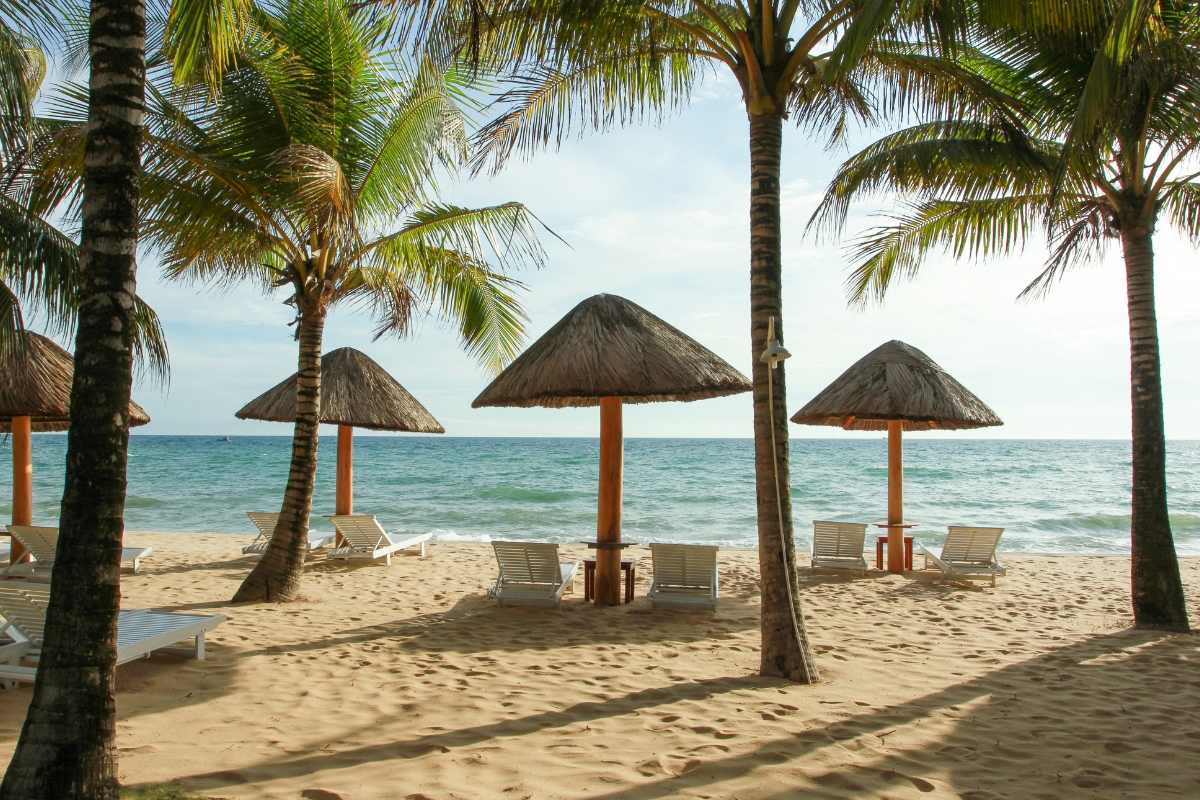Phu Quoc, Vietnam’s tropical island gem in the Gulf of Thailand, is renowned for its pristine white-sand beaches, crystal-clear waters, lush tropical landscapes, and a burgeoning culinary scene. Whether you’re planning a relaxing beach holiday, an adventurous snorkeling trip, or a cultural exploration of local fishing villages, knowing the best time to visit Phu Quoc is key to an unforgettable vacation. In this guide, we’ll break down Phu Quoc’s climate, monthly weather trends, tourist seasonality, cost considerations, and local events, helping you decide when to go to Phu Quoc for the ideal getaway.
1. Introduction
Phu Quoc offers a diverse blend of natural beauty and laid-back island life. With its stunning beaches, vibrant coral reefs, and emerging luxury resorts, this island destination is perfect for families, couples, and solo travelers alike. Many visitors ask, “what is the best time to visit Phu Quoc?” or wonder, “when to go to Phu Quoc” to ensure they enjoy ideal weather and fewer crowds. This comprehensive guide is designed to help you determine the best month on Phu Quoc for your trip, balancing outdoor adventures, relaxation, and cultural experiences.
2. Understanding Phu Quoc’s Climate
General Weather Patterns
Phu Quoc experiences a tropical monsoon climate with two main seasons:
- Dry Season (November to April):
The dry season brings warm, sunny days and lower humidity. This period is ideal for beach activities, water sports, and exploring the island’s natural attractions. Clear skies and calm seas make it the preferred time for visitors. - Wet Season (May to October):
The wet season sees increased rainfall and higher humidity. While rain showers are usually short-lived and often occur in the afternoon, the island’s lush greenery comes alive during this period. Although some outdoor activities may be disrupted by rain, the wet season offers quieter beaches and better deals.
Seasonal Variations
Phu Quoc’s temperatures remain relatively stable year-round, generally between 26°C and 32°C (79°F to 90°F). The main differences lie in the frequency and intensity of rainfall. Understanding these variations is essential when deciding the best time to visit Phu Quoc for your desired activities—whether you’re looking for uninterrupted beach days or a more budget-friendly, less crowded experience.
3. Monthly Weather Breakdown
Rainfall and Temperature Trends
- November to April (Dry Season):
During these months, expect abundant sunshine, lower humidity, and minimal rain. Average temperatures range from 26°C to 32°C (79°F to 90°F), making it perfect for swimming, sunbathing, and snorkeling. This is widely regarded as the best time to visit Phu Quoc for those who prioritize beach activities and outdoor exploration. - May to October (Wet Season):
This period experiences higher rainfall, with intermittent showers that are usually brief. While the island remains warm, the increased humidity and occasional heavy downpours can affect outdoor plans. However, these months offer lush landscapes and fewer tourists, which might be appealing for those seeking a more tranquil escape.
Impact on Outdoor Activities
- Beach and Water Sports:
The dry season offers optimal conditions for swimming, diving, and other water activities, thanks to clear skies and calm seas. - Exploring Local Culture:
Clear weather in the dry season also makes it an excellent time for exploring local markets, fishing villages, and historical sites. - Nature and Wildlife:
While the wet season brings vibrant greenery and dramatic coastal views, it requires a bit more flexibility in planning outdoor adventures.
4. Tourist Seasonality and Trends
Monthly Tourist Numbers
- Peak Season (November to April):
The dry season attracts the highest number of visitors due to its consistently good weather. This is the best time to visit Phu Quoc for sun-soaked beach days and lively water sports. However, increased demand means higher prices for accommodations and tours. - Shoulder Season (Late April and October):
These transitional months provide a good balance between pleasant weather and moderate tourist numbers. They are an attractive time to go to Phu Quoc if you’re looking for fewer crowds and more competitive pricing. - Low Season (May to September):
The wet season sees a decline in visitor numbers, which results in quieter beaches and often more personalized service. Although you may encounter occasional rain, this period is ideal for budget travelers seeking a peaceful retreat.
Advantages and Disadvantages
Peak Season (Dry Season):
- Advantages:
- Consistently ideal weather for all outdoor activities.
- A full range of tours, water sports, and cultural events available.
- Disadvantages:
- Higher prices for flights and accommodations.
- More crowded beaches and tourist hotspots.
Shoulder Season:
- Advantages:
- Pleasant weather with fewer crowds.
- Better pricing and more flexible booking options.
- Disadvantages:
- Transitional weather can sometimes be unpredictable.
Low Season (Wet Season):
- Advantages:
- Lower costs and a more intimate, laid-back atmosphere.
- Disadvantages:
- Increased chance of rain might disrupt some outdoor plans.
5. Cost Considerations for Travelers
Accommodation Pricing Trends
Phu Quoc offers everything from luxury beach resorts and private villas to budget-friendly hotels and guesthouses:
- Peak Season:
Accommodation rates are at their highest during the dry season due to high demand. Early bookings are recommended. - Shoulder Season:
Prices tend to be more competitive, and many properties offer attractive packages including meals or guided tours. - Low Season:
The off-peak months feature significantly lower prices, making it an excellent option for travelers on a budget.
Flight and Transport Costs
Airfare and local transport costs vary with the tourist season:
- Peak Season:
Expect higher prices for flights and transfers. - Shoulder and Low Seasons:
Lower demand generally leads to discounted fares and attractive promotions.
Budgeting Tips
- Plan Ahead:
Secure your flights and accommodations well in advance, especially for peak season travel. - Compare Deals:
Use online travel platforms and fare alerts to find the best offers. - Consider Package Deals:
All-inclusive or bundled packages can lead to significant savings. - Stay Flexible:
A slight adjustment in travel dates may result in lower prices.
6. Other Essential Factors
Local Events and Cultural Experiences
Phu Quoc is not just about beaches—its local culture and events add to its charm:
- Seafood and Culinary Tours:
Enjoy fresh seafood and local Vietnamese cuisine at bustling night markets and upscale restaurants alike. - Fishing Villages:
Visit traditional fishing villages to experience authentic island life and vibrant local crafts. - Cultural Festivals:
Check the local calendar for traditional festivals and events that showcase the island’s heritage and music.
Water Conditions for Beach and Water Sports
Phu Quoc’s crystal-clear waters are perfect for a range of activities:
- Dry Season:
Ideal for swimming, snorkeling, diving, and sailing due to calm seas and excellent visibility. - Wet Season:
While occasional showers may occur, many water activities are still enjoyable during dry spells.
Special Offers and Packages
Watch for seasonal promotions that can enhance your stay:
- Discounted Rates:
Many resorts offer special deals during the shoulder and low seasons. - Bundled Packages:
Look for packages that include tours, meals, or spa treatments. - Last-Minute Offers:
Flexibility with your travel dates may allow you to benefit from attractive last-minute deals.
7. Comparative Analysis: Finding the Best Month
Choosing the best time to visit Phu Quoc depends on your travel goals:
- For Beach Lovers and Water Sports Enthusiasts:
The dry season (November to April) provides ideal conditions for beach activities and water sports. Many travelers consider this period as the best time to visit Phu Quoc for its sunny skies and warm, inviting waters. - For Cultural and Budget Travelers:
The shoulder season, particularly October, offers a balanced mix of pleasant weather, fewer crowds, and better prices. This is often regarded as the best month on Phu Quoc for a well-rounded experience. - For a Quieter, Intimate Escape:
The wet season (May to September) brings lower prices and a more relaxed atmosphere, although you may need to plan outdoor activities around occasional showers.
8. Tips for a Successful Trip
Planning and Booking Strategies
- Book Early:
Secure your flights and accommodations ahead of time, particularly during peak season. - Use Comparison Tools:
Online travel platforms and fare alerts are invaluable for finding the best deals. - Stay Flexible:
Consider adjusting your travel dates to take advantage of lower rates during shoulder or low seasons. - Gather Local Insights:
Engage with travel forums and local guides to learn about hidden gems and current conditions on Phu Quoc.
What to Pack for Different Seasons
- Dry Season Essentials (November to April):
Pack lightweight, breathable clothing, swimwear, sunglasses, a wide-brimmed hat, and high-SPF sunscreen. Comfortable sandals or flip-flops and a cover-up for evenings are also recommended. - Wet Season Essentials (May to September):
In addition to tropical attire, bring a waterproof jacket or umbrella and quick-dry clothing to stay comfortable during occasional rain showers. - Versatile Accessories:
A reusable water bottle, a good camera, and snorkeling gear (if you prefer using your own) will enhance your experience.
Insider Advice for Visitors
- Local Transportation:
Options include taxis, motorbike rentals, and organized tours. Consider hiring a local guide to enhance your cultural and natural explorations. - Dining:
Sample both street food and upscale restaurants to enjoy the full range of local Vietnamese cuisine. - Cultural Etiquette:
A friendly smile and a willingness to learn about local customs can enrich your travel experience. - Health and Safety:
Phu Quoc is generally safe for travelers. Standard precautions like keeping your belongings secure and staying hydrated are recommended.
9. Conclusion
Determining when to go to Phu Quoc ultimately depends on your travel priorities. If you’re seeking perfect beach conditions and vibrant water sports, the dry season (November to April) is the best time to visit Phu Quoc, offering sun-drenched days and calm seas. For those looking for a balanced, more budget-friendly experience with fewer tourists, many travelers find that October is the best month on Phu Quoc—providing a pleasant climate, lower prices, and an ideal mix of relaxation and exploration. By considering Phu Quoc’s climate, seasonal trends, cost factors, and local cultural experiences, you can design an itinerary that perfectly matches your dream getaway.
10. Frequently Asked Questions (FAQ)
Q: When is the best time to visit Phu Quoc?
A: The best time to visit Phu Quoc is generally during the dry season (November to April), when the weather is sunny and ideal for beach activities.
Q: When to go to Phu Quoc if I want fewer crowds and better deals?
A: Consider the shoulder season, particularly October, which is often regarded as the best month on Phu Quoc for a balanced experience with pleasant weather and lower prices.
Q: Are there significant price differences between seasons in Phu Quoc?
A: Yes. Peak season sees higher prices for accommodations and flights, while shoulder and low seasons offer more competitive rates and attractive deals.
Q: What kind of activities are best enjoyed during the dry season in Phu Quoc?
A: The dry season provides optimal conditions for swimming, snorkeling, diving, and other water sports, as well as exploring local fishing villages and cultural attractions.
Q: Is Phu Quoc suitable for both beach lovers and cultural explorers?
A: Absolutely. Phu Quoc offers gorgeous beaches and excellent water sports, as well as rich local culture and delicious cuisine, making it a versatile destination for every type of traveler.

